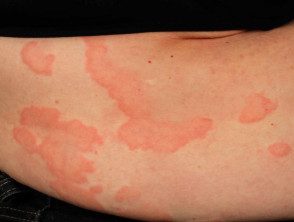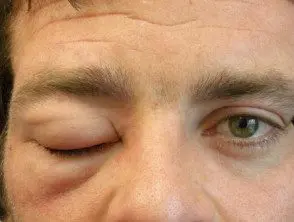What is induced exercise? anaphylaxis?
Exercise-induced anaphylaxis is a rare but life-threatening disease. hypersensitivity reaction triggered by physical activity. The symptoms are due to a massive degranulation of mast cells. They include:
- Urticaria and angioedema
- Nausea and vomiting
- Breathing difficulty due to the airway. constriction
- Hypotension (shock).
Urticaria and angioedema.

Urticaria

Urticaria

Angioedema
What Causes Exercise-Induced Anaphylaxis?
the pathophysiology of exercise-induced anaphylaxis is not fully understood. Symptoms are caused by histamine and tryptase, which are released on mast cell activation and degranulation. Patients with exercise-induced anaphylaxis show a decreased threshold for mast cells degranulation, but the reason is unknown.
Who Gets Exercise-Induced Anaphylaxis?
Exercise-induced anaphylaxis accounts for 5 to 15% of anaphylaxis cases. the predominance Exercise-induced anaphylaxis is believed to be about 50 to 2,000 episodes per 100,000 people per year.
Most affected patients exercise regularly, but only occasionally experience anaphylaxis.
Exercise-induced anaphylaxis is usually sporadic, but there are some reported family cases. Onset usually occurs between 10 and 30 years of age, but cases have been reported in children as young as 3 years. Women are twice as likely as men to experience exercise-induced anaphylaxis.
What Kind of Exercise Triggers Exercise-Induced Anaphylaxis?
Symptoms are usually triggered during moderate exercise, such as jogging, tennis, dancing, and biking. The episodes are not completely predictable, as the same exercise may not trigger exercise-induced anaphylaxis every time.
What are the clinical features of exercise-induced anaphylaxis?
The clinical features of exercise-induced anaphylaxis are similar to other types of anaphylaxis. Symptoms usually begin within 30 minutes of starting exercise, but can occur at any time during physical activity. As exercise progresses, symptoms become more severe, to the point of cardiovascular collapse. Stopping exercise usually produces immediate improvement, but some patients continue to experience symptoms for up to 1 hour later. The main systems and organs affected are the skin, the respiratory tract, the gastrointestinal tract, and the cardiovascular system.
Prodromal symptoms include fatigue, generalized pruritus and erythema. Commonly, these are followed by:
- Pruritus (92%)
-
Urticaria (86%)
-
Angioedema (72%)
-
Washing (70%)
- Shortness of breath (51%).
Less commonly, exercise-induced anaphylaxis can be accompanied by gastrointestinal symptoms such as nausea, vomiting, abdominal cramps, and diarrhea, as well as syncope, dysphagia, chest tightness, sweating, choking, throat constriction, headache and hoarseness.
Food-dependent exercise-induced anaphylaxis
Food-dependent, exercise-induced anaphylaxis affects one-third to one-half of patients with exercise-induced anaphylaxis. A anaphylactic The answer can occur when you exercise between 1 and 3 hours after eating. Symptoms do not occur after eating a meal without exercise, nor do they occur during exercise if the trigger foods have not been consumed.
The main foods that can cause food-dependent exercise-induced anaphylaxis are:
- Wheat
- Seafood
- Tomatoes
- Misery
- Corn.
The symptoms are the same as in exercise-induced anaphylaxis.
What are the complications of exercise-induced anaphylaxis?
One third of patients with exercise-induced anaphylaxis experience cardiovascular symptoms, including fainting or impaired consciousness. Death from exercise-induced anaphylaxis is rare, although this condition can be life-threatening and must be treated urgently.
How is exercise-induced anaphylaxis diagnosed?
The diagnosis of exercise-induced anaphylaxis is based on the medical history and physical examination. Triggering events for anaphylaxis should be determined, such as whether it is induced by exercise alone or whether it has any association with food.
Which is the differential diagnosis of exercise-induced anaphylaxis?
Other types of anaphylaxis that can accompany exercise include cold urticaria (exposure to cold while swimming) or drug-induced anaphylaxis (due to non-steroidal anti-steroid action).inflammatory drugs [[NSAID] taken during exercise).
If there is no clear history of anaphylaxis, other disorders should be considered, including:
- Cholinergic urticaria
- Mastocytosis
- Hereditary angioedema
- Exercise-induced asthma
- Idiopathic anaphylaxis
-
Pheochromocytoma
What is the treatment for exercise-induced anaphylaxis?
Anaphylaxis should be treated as a medical emergency. Treatment of exercise-induced anaphylaxis is similar to other types of anaphylaxis.
Treatment of type I hypersensitivity reactions includes:
-
Adrenaline (intramuscularly, to decrease airway inflammation and cardiovascular symptoms)
- Systemic glucocorticosteroids (to decrease the inflammatory reaction)
-
Antihistamines (to counteract the effect of released histamine).
Patients should avoid the anaphylactic trigger in the future. If exercise is part of a patient's regular routine, they may need to be instructed on the use of an adrenaline pen or pre-filled adrenaline syringe for emergency situations. Patients must know how to identify the early symptoms of exercise-induced anaphylaxis.

